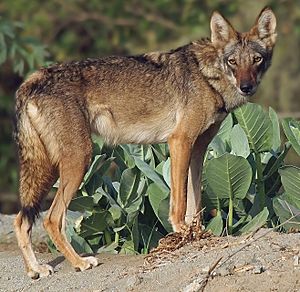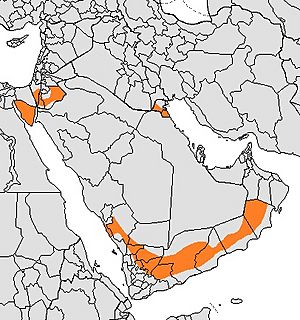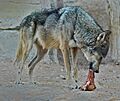Arabian wolf facts for kids
Quick facts for kids Arabian wolf |
|
|---|---|
 |
|
| Conservation status | |
| Scientific classification |
|
| Kingdom: | Animalia |
| Phylum: | Chordata |
| Class: | Mammalia |
| Order: | Carnivora |
| Family: | Canidae |
| Genus: | Canis |
| Species: | |
| Subspecies: |
C. l. arabs
|
| Trinomial name | |
| Canis lupus arabs Pocock, 1934
|
|
 |
|
| Arabian wolf range | |
The Arabian wolf (Canis lupus arabs) is a special kind of gray wolf. It lives in the Arabian Peninsula, which includes places like Oman, southern Saudi Arabia, and Yemen. You can also find it in Israel's Negev Desert and Arava Deserts, Jordan, Palestine, and Egypt's Sinai Peninsula.
This wolf is the smallest type of gray wolf. It is an expert at living in dry, hot places, like deserts. Arabian wolves usually live in small family groups. They eat many different things, from insects and reptiles to small birds and rodents. They also hunt small hoofed animals, such as young Nubian ibex and different kinds of gazelles.
Contents
What Makes Them Special?
The Arabian wolf is one of the smallest types of wolves in the world. An adult wolf usually stands about 63 to 66 centimeters (25-26 inches) tall at the shoulder. It weighs around 20 kilograms (45 pounds). Its skull is also smaller than most other wolves.
Built for the Desert
Being smaller helps this wolf live in hot, dry climates. This is a natural way animals adapt to their environment. Their ears are quite large compared to their body size. Big ears help them release body heat and stay cool in the desert sun.
They have a short, thin coat of fur, which is usually a grayish-beige color. Some Arabian wolves in Saudi Arabia have darker, almost black fur. Like other dog-like animals, wolves don't sweat. They cool down by panting quickly, which helps water evaporate from their lungs. Sometimes, the pads of their third and fourth toes are joined together at the back. This unique feature can help tell their tracks apart from a domestic dog's.
A Look at Their Family Tree
Scientists have studied the Arabian wolf for a long time. In 1934, a British zoologist named Reginald Innes Pocock officially named this wolf Canis lupus arabs. He noticed it had a smaller skull and was smaller overall compared to other wolves.
More recent studies, including genetic research, show that the Arabian wolf is a distinct type of gray wolf. Sometimes, Arabian wolves have mixed genes with domestic dogs. This mixing can make it harder for them to stay perfectly adapted to their desert home. Scientists continue to study these wolves to understand their unique traits.
Scientists have also looked at how Arabian wolves are related to other dog-like animals. They found that Arabian wolves sometimes share genes with African golden wolves and golden jackals. This shows how different animal groups can connect and share genes over time, especially in places like the land bridge between Africa and Asia.
Wolf Families and Food
Arabian wolves usually don't live in very large groups. They often hunt in pairs or in small groups of three or four animals. They are most active around water sources in the morning and afternoon. However, they often travel more at night. These wolves sometimes live near human towns because they can find food there.
What Do They Eat?
Arabian wolves are mainly meat-eaters, but they also eat other things. In some areas, they even rely on human garbage or leftover food. Their natural diet includes hoofed animals like Nubian ibex and different kinds of gazelles. They also hunt smaller animals such as hares, rodents, small birds, and reptiles. They might also eat cats, sweet fruits, and dead animals found on roads. They are very good at finding food and will eat almost any small animal, including fish or snails.
Because Arabian wolves can sometimes hunt farm animals like goats, farmers and herders sometimes try to protect their livestock from them.
How Wolves Help Nature
Arabian wolves play an important role in their environment. For example, in Israel, a striped hyena was once seen working together with a wolf pack. The hyena might have helped the wolves find food with its strong sense of smell, while the wolves were better at hunting larger prey. This is an example of animals helping each other.
Wolves also help keep the balance of nature by controlling the numbers of smaller meat-eating animals like golden jackals and foxes. This allows plant-eating animals to thrive. Arabian wolves also compete for food with other predators like the caracal and the Arabian leopard. Long ago, they also competed with the Asiatic cheetah, but that animal no longer lives in the Arabian wolf's habitat.
Where Do They Live?
The Arabian wolf used to live all across the Arabian Peninsula. Today, they are found in smaller areas in southern Israel, Palestine, Oman, Yemen, Jordan, Saudi Arabia, and parts of the Sinai Peninsula in Egypt. They are rare in many places because of human activities. Wolves often travel between countries like Egypt, Israel, and Jordan, which helps keep their populations connected.
Protecting These Wolves
Good news! In Oman, the number of wolves has grown because hunting is not allowed. This means they might naturally spread to new areas soon.
In Israel, there are about 100 to 150 Arabian wolves living in the Negev and Arava deserts. Their population is stable because there is plenty of prey, and much of their land is protected as nature reserves. They also find extra food and water near farms. These wolves are strongly protected by Israel's wildlife laws.
The United Arab Emirates and Egypt have special programs to breed Arabian wolves in zoos to help their numbers grow. The wolf is also protected in Oman and Israel. Some areas in Saudi Arabia also protect these wolves, and they can still be found in places where there are not many people.
Images for kids
-
An Arabian wolf at the Al Ain Zoo in the United Arab Emirates.
See also
 In Spanish: Lobo árabe para niños
In Spanish: Lobo árabe para niños






